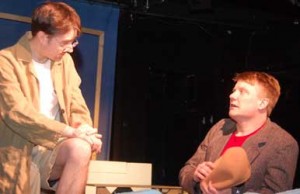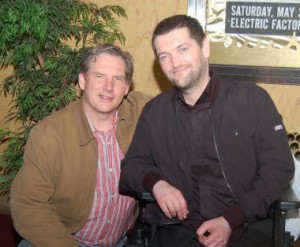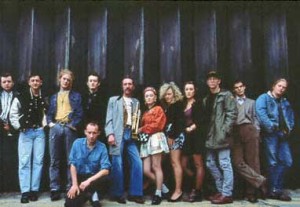Marie Jones’ award-winning comedy, “Stones in His Pockets,” is classified as a two-hander. In theatre jargon, that means there are two main characters.
Maybe they call it that because to call it a 30-hander would seem physically impossible. And yet, here you have two veteran local actors, Chris Faith and Tony Braithwaite, intrepidly embodying 15 characters, with all of the action compressed into one tight, fast-moving little show.
(Editor’s note: There’s been a recent change in the cast. See below.)
“Stones in His Pockets” is about what happens when a Hollywood movie company descends upon a tiny town in County Kerry. The show, directed by William Roudebush, starts September 2 (press opening on the 5th) and runs through September 27 at the cozy Act II Playhouse in Ambler.
(And for those of you who just can’t wait to see this multiple award-winning comedy, stay tuned for news about a sneak preview that is also a benefit for the Hibernian Hunger Project.)
Braithwaite and Faith have worked together before, including their 2005 performance of “Good Evening,” by Peter Cook and Dudley Moore. That’s right—a two-hander. And, technically, yes, they’re two characters in “Stones”— Charlie Conlon and Jake Quinn, who hired on as extras for the film, a hyper-romantic view of the Emerald Isle. But the play also requires that they fill a whole lot of other shoes.
“Good Evening” posed a challenge, Braithwaite recalls. There were two characters on stage from beginning to end, and they assumed other characters. But, says Faith, “in this play there can be three or four characters on stage at the same time … or more, even.”
So as bad as it is to step on another actor’s lines in a play, Braithwaite and Faith have the potential to step on their own. Or worse, adds Braithwaite: “Showing up as the wrong character for a split second, and then realizing that you have to turn the hat around a little bit, or whatever that character’s little flair is.”
In rehearsals, Faith is wrestling wth similar issues: “I can hear when a voice from another character creeps into the voice I’m doing, and I pull back. For now, it’s fine-tuning all that stuff.”
Juggling the multiple personalities also poses a challenge for the director.
“Oftentimes when characters play multiple roles they go off and they come back on as another character, which makes immense sense,” says William Roudebush. “But sometimes the changes are instantaneous, right in front of your eyes. Part of what I’m trying to do as a director is to make that change very magical, to take advantage of the moment.”
Another challenge: Playing Irish, which Braithwaite has done before. He played the character Paddy O’Gratin in “The Big Bang,” described as a “madcap tour of history.”
“He sang to his potato, the last potato in Ireland,” he recalls. “It was a love song. That was the last and the only time I ever had to do Irish.”
For Faith, putting on an accent—something that sounds something other than “stage Irish”—is a new experience. “It’s challenging,” he says, “but I think there are three major sounds we’ve got to hit all the time. I think that, if we’re in the ballpark, we’ll be OK.”
Though “Stones” is a comedy, Roudebush says it’s his goal to treat all 15 of those characters, especially the Irish, with respect. “The soul of the play is Irish,” he says. “It’s a great honor and challenge to have to try and live up to that—and not make it a cliché, that’s for sure.”
All three describe themselves as journeymen—or, as Roudebush quips, “I like to say that my job is finding work.”
Roudebush has been “finding work” for over 30 years. His 2002 revival of “Equus” was nominated for eight Barrymore awards and won five, including Best Overall Production of a play, Best Ensemble and Best Director. He has taught at The American Academy of Dramatic Arts in New York, The University of Memphis, The University of the Arts, Virginia Commonwealth University, along with being Theatre School Director for the Walnut Street Theatre for four years. He is currently director of musical theatre for the Performing Arts Institute in Kingston, Pa.
Both the actors are well-known in Philadelphia theatre. Like most actors, they do—or have done—other things. But what they do all the time—because to do otherwise would be unthinkable—is act, and when they’re not doing that, looking for opportunities to act some more.
Braithwaite, a Barrymore award winner (for the role of Boyd in “The Big Bang”) used to teach theology, theatre—and sex education to freshmen—at St. Joe’s Prep: “I used to say—I teach theatre, theology and sex ed, so we do ‘Agnes of God’ every year.” (Cue the rim shot.) He still directs shows at St. Joe’s.
Faith has appeared Off-Broadway in “The Secret Garden” and “Like It Is” at the York Theatre. He is a three-time Barrymore Award nominee. He and his wife have a children’s performing arts studio in Plumsteadville.
Now, as to that sneak preview:
The final dress rehearsal of “Stones in His Pockets” will be open to the public on Sunday, August 31, at 2 p.m. The suggested donation is $10, and all contributions will be donated to the Hibernian Hunger Project, a community service program that feeds needy people in the Philadelphia/Camden area. (Hey, how can you call yourself a Hibernian and not go?)
Three preview performances will be held September 2-4, with tickets discounted at $20. Talkbacks will be held after the first two 8 p.m. previews, as well as on Thursday, September 11, at 8 p.m. and Sunday, September 21, at 2 p.m.
Opening night is September 5, followed by a reception. All evening performances are at 8 p.m., and matinees begin at 2 p.m. on Wednesdays and Sundays.
Tickets are $25 for all Wednesday-Thursday performances and $30 for Friday through Sunday shows, with discounts available for groups of 10 or more. Tickets are available by calling the Act II Box Office at (215) 654-0200 or online at www.act2.org.
Act II is at 56 East Butler Avenue, just a block from another venerable borough institution, The Shanachie Pub. Shanachie is also a show supporter. Look for an opening night appearance by the pub’s co-owner, singer Gerry Timlin.
P.S.: We’re supporters, too, even though it’s mostly moral support.
Editor’s note: Broadway and Irish actor Declan Mooney is stepping into the role of Charlie Conlon. Mooney, who joins Tony Braithwaite in rehearsal, replaces Chris Faith, who was forced to leave the show due to a family emergency.
Mooney will easily fill the shoes of Faith. He has performed the role of Charlie two other times, including as stand-in for Tony-nominated Conleth Hill in the Broadway production of the play. Dialect training will not be necessary for Mooney: He hails from Downpatrick in County Down, Ireland, and came to the States to attend college on a soccer scholarship.




